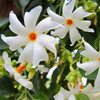Green Paradise Offers Beautiful Shiva Linga Tree
About a Shiva Linga tree
The Shivalinga tree, scientifically known as Couroupita guianensis, is a large, tropical tree native to the rainforests of Central and South America, including the Amazon Basin. It is also commonly found in parts of the Caribbean, India, and Southeast Asia. The tree is named after its distinctive fruit, which resembles a cannonball.
Here are some key features and characteristics of the Shivalinga tree:
Appearance:
The Shivalinga tree is an evergreen tree that can grow up to 25 meters (82 feet) in height. It has a straight trunk with a grayish-brown bark that is smooth when young but develops fissures with age. The branches form a dense, spreading crown. The leaves are large, alternate, and pinnate, consisting of 5 to 11 leaflets with a glossy green color.
Flowers:
One of the most remarkable features of the Shivalinga tree is its unique flowers. They are large, showy, and fragrant, often measuring up to 5 centimeters (2 inches) in diameter. The flowers grow in clusters at the ends of long, drooping stalks called inflorescences. Each inflorescence can bear dozens of flowers. The flower has six petals that are either white, yellow, or pink, with numerous long stamens at the center.
Fruit:
The tree produces large, round, woody fruits that resemble cannonballs, hence its common name. These fruits can grow to be about the size of a human head, typically measuring 15 to 24 centimeters (6 to 10 inches) in diameter. The fruits are brown and have a hard, knobby exterior. When ripe, they split open, revealing numerous seeds embedded in soft, pulpy, and fragrant flesh.
Cultural Significance:
The Shiva linga tree holds cultural and religious significance in several regions where it grows. In India, it is commonly found in temple courtyards and is associated with Lord Shiva. The tree is revered for its sacred and auspicious nature. In some cultures, the fallen fruits are considered a symbol of fertility and abundance.
Medicinal and Traditional Uses:
Various parts of the Shivalinga tree have been used in traditional medicine. The bark, leaves, flowers, and fruits contain active compounds with potential therapeutic properties. They have been used to treat ailments such as fever, pain, inflammation, skin diseases, and digestive disorders. However, it's important to note that scientific studies on its medicinal efficacy and safety are limited.
Wildlife and Ecology:
The Shivalinga tree attracts a variety of pollinators, including bees, butterflies, and birds, with its large, fragrant flowers. The flowers produce copious amounts of nectar, which serves as a food source for these pollinators. The fallen fruits are eaten by animals like monkeys, bats, and wild boars, which aid in seed dispersal.
It's worth noting that the Shivalinga tree is not commonly found in cultivation outside its native range due to its specific growth requirements and the large size it attains. However, in areas where it does grow, it adds beauty and uniqueness to the tropical landscapes it inhabits.
How To Grow Shivalinga Tree
Growing a Cannonball tree (Couroupita guianensis) can be rewarding but challenging, especially if you live outside its native range. Here are some general guidelines to help you grow a Cannonball tree:
Climate and Location:
Cannonball trees thrive in tropical and subtropical climates. They prefer warm temperatures, high humidity, and ample rainfall. Select a location that receives full sun or partial shade throughout the day. The tree requires well-draining soil, preferably rich in organic matter.
Propagation:
Cannonball trees can be propagated from seeds. Obtain fresh seeds from a reliable source, as they have a short viability period. Soak the seeds in water for 24 to 48 hours to soften the hard seed coat. This will aid in germination.
Germination and Seedling Care:
Fill a pot or seed tray with a well-draining potting mix. Plant the seeds about 2-3 centimeters (1 inch) deep in the soil and cover them lightly. Place the container in a warm and humid environment. Maintain consistent moisture by misting the soil regularly. Germination can take several weeks to months. Once the seedlings emerge, provide them with bright, indirect light and gradually acclimate them to outdoor conditions.
Transplanting:
When the seedlings have grown to a suitable size (around 30 centimeters or 12 inches), they can be transplanted into larger pots or directly into the ground. Ensure the soil in the new planting location is well-prepared and enriched with organic matter. Choose a spacious area that allows the tree to grow to its full size without restrictions.
Watering and Fertilization:
Cannonball trees require regular watering to keep the soil consistently moist. However, avoid overwatering, as it can lead to root rot. During dry periods, increase the frequency of watering. Fertilize the tree with a balanced slow-release fertilizer during the growing season to provide necessary nutrients. Follow the manufacturer's instructions for dosage and application.
Pruning and Maintenance:
Prune the tree sparingly, mainly to remove dead or damaged branches. Pruning can be done during the dormant season to stimulate new growth. Regularly check for pests and diseases, and take appropriate measures to control them.
Patience:
It's important to note that Cannonball trees are slow-growing and may take several years to reach maturity and produce flowers and fruits. Be patient and provide consistent care and optimal growing conditions.
Please remember that successfully growing a Cannonball tree outside its native range can be challenging due to the specific climatic requirements and the tree's large size. It's advisable to consult with local horticultural experts or botanic gardens for region-specific advice and guidance.










